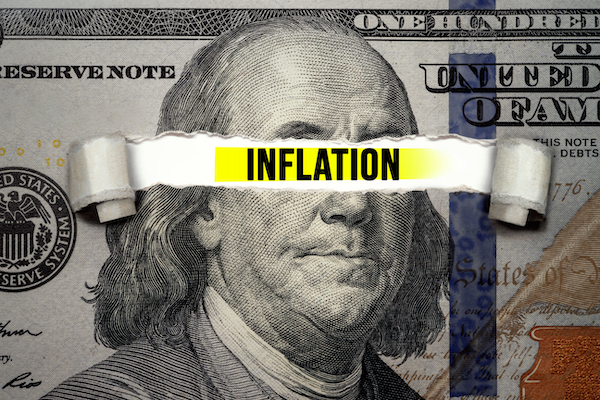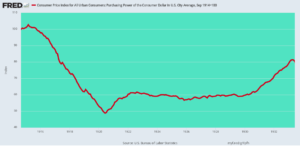
The pre-1971 history shows beyond a shadow of doubt that you do not require a set rate of inflation to enable financial growth, as today’s central lenders and their Wall Street acolytes endlessly insist. And it also advises us that there is not some inherent propensity for the currency to relentlessly diminish.
Today’s 2% inflation mantra was constructed from the incorrect research by Milton Friedman and his disciple, Ben Bernanke, based on the period before WWII. They studied the Anxiety years after 1929 and generally concluded that we need inflation to avoid any possible comparable deflation duration. However they failed to take a look at the essential 15-year period preceding the Great Anxiety.
What happened was this.
In November 1914, the Fed opened for organization and was then promptly prepared to finance America’s ill-fated entry into World War I (WWI).
The impact of enormous cash printing to finance the war was a51%depreciation of the dollar’s buying power by the crest of the post-WWI inflation in June 1920.
Federal governments had actually sold war bonds to both their financier class and typical people alike, guaranteeing that they would be redeemed after completion of hostilities at the pre-war gold parity.
Odd as it sounds to modern-day ears, governments back in those days took their pledges– particularly in matters of money– extremely seriously.
The effort to resume gold convertibility at the pre-war parity (which was the sound thing to do) is what resulted in the Great Depression. As with any major crisis, this was a challenging period for all the people and would have been completely unnecessary if the government wouldn’t have pumped up the dollar in the very first place.
What is not stated is that the Great Depression would have been a lot less unpleasant and much shorter had it not been for Roosevelt’s New Deal.
As revealed by the chart below, the United States dollar was well on its method to the repair of its 1914 value, having actually recovered 60% of the loss from the June 1920 bottom by the time FDR’s (Franklin D. Roosevelt’s) 100-day New Deal was enacted in June 1933.
Index Of The Dollar’s Buying power From The Fed’s Opening To June 1933

The New Offer put the kibosh on sound money when Roosevelt cheapened the dollar by 59% in early 1934, and needing all holders of gold and gold certificates to surrender them in return for unbacked U.S. Treasury bonds.
But already, the natural part of the anxiety– the purge of WWI and Roaring Twenties excesses– was currently over.
Yet, what the fiat cash twins– Friedman and Bernanke– did was to blame the repair of the dollar’s value in the early 1930s for the Great Depression. They referred to this positive development by the negative term “deflation” and held that it arised from the fact that the cash supply (M1 or currency and deposits) in the banking system contracted dramatically during the 4 years after the October 1929 crash.
The so-called “deflation” was truly nothing more than a belated and old-fashioned attempt to purge the economy of war inflation, a procedure that the world at that time well comprehended.
The 1929– 1933 did not prove that commercialism has some kind of deflationary death dream nor that gold-backed cash inherently causes financial contraction.
Market industrialism does not slip into an irreparable deflationary spiral on its own.
And we definitely do not require central lenders to target a 2.00% or much better rise in the basic rate level so that inflation doesn’t run too near the 0.0% edge and threat slipping into the abyss. There is no void– that’s simply a hassle-free fiction of Keynesian central lenders.
Editor’s Note: The 2020s will likely to be a significantly volatile time. More federal governments are putting their cash printing on overdrive. Negative interests are becoming the rule rather of the exception to it.
Something is for sure, there will be a great deal of modification occurring in the years ahead.
That’s exactly why famous speculator Doug Casey and his team released an urgent new report entitled

